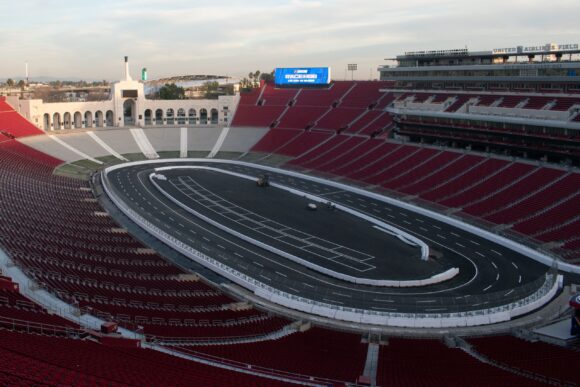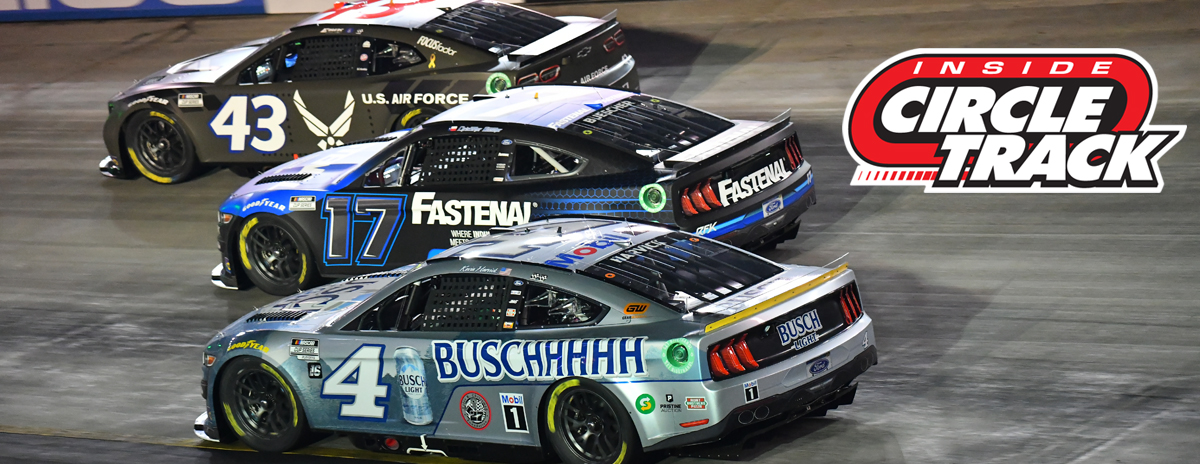
The L.A. Coliseum as a race track(Photo: NASCAR Media)
The Los Angeles Memorial Coliseum is no stranger to big events. The Green Bay Packers defeated the Kansas City Chiefs to win Super Bowl I and the Miami Dolphins topped the Washington Redskins to win Super Bowl VII on the grounds of that stadium. And that’s not all. This building is the only venue in the world to have ever hosted the Super Bowl, the World Series, and the Olympic Games.
This weekend, however, the L.A. Coliseum may very well host the most unique event in its storied history when the NASCAR Cup Series stages its season-opening Busch Light Clash at The Coliseum. The exhibition race will take place on a quarter-mile makeshift paved oval race track with the sport’s biggest stars being pitted against each other in a 150-lap showdown.
This will not be the first time an auto race has been held inside a football stadium. In 1956, Fireball Roberts won a 100-mile event held inside of Chicago’s Soldier Field. Bowman-Gray Stadium in Winston-Salem, NC has staged racing events for many years. And, the Dome at Americas Center in St. Louis(former home of the Rams) has hosted the Gateway Dirt Nationals for Dirt Late Models and other classes for some time as well.
This will be the first time that such a high-profile race will be held in front of a network television audience. And potentially, of course, the race could be run in front of a large crowd that has had little exposure to the sport in the country’s second biggest city.
An exhibition race in front of a large and previously untapped market on a track that almost certainly will lead to contact between cars has the possibility of scoring major publicity points for NASCAR. Yes, there have been races held in the Los Angeles area before but not in a venue such as this located close to the city’s center.
At the same time, though, there is also the possibility that this idea could backfire.
Racing such high powered cars on the smallest track the NASCAR Cup Series will have used in decades will almost certainly lead to lots of beating and banging. Of course, a little bent sheet metal is typical good for business when it comes to short track racing. But on the other hand, an excessive number of cautions, particularly for single-car spins, with only small amounts of racing mixed in sporadically could prove to be a bit tedious and even boring.
But even if the race does devolve into a caution-fest, could it possibly be any worse than the 2020 version of the Clash held at Daytona International Speedway when the battered car of Erik Jones beat the other remaining five cars in that event to the finish line? That race was a wreck-fest beyond all proportions.
The Clash will employ a format that will feature qualifying, heat races and last chance qualifiers to set the 23-car field that will start the 150-lap main event. A halftime break will take place after the completion of 75 laps which will provide an opportunity for teams to work on their cars.
Purists may not like the fact that this will be a happening as much as it is a race. A pre-race concert by Trackhouse Racing co-owner Pit Bull will be held. Rapper Ice Cube will perform a show during the halftime portion of the feature race.
But the important thing to remember is that this is a show, not a race in the truest sense of the word. It is being held in a unique location inside of a big city for the purpose of attracting new fans to the sport. And to do that, there has to be something other than the competition that might ultimately get the eyes of nonrace fans focused onto the racing after they initially purchased a ticket or tuned in for the entertainment.
Again, this is an exhibition. If halftime breaks with concerts were to be incorporated into points-paying NASCAR races, that would be a problem. But for such an event as this, mixing in a little entertainment is acceptable.
But what if this does turn out to be a flop?
If that proves to be the case and the gamble of paving a football field turns into a caution-filled disaster, there will actually be little cost in the long run in terms of building a bigger audience. If it turns out that very few new fans are made, those people weren’t fans anyway so nothing is lost. And it seems pretty unlikely that longtime fans will depart the sport because of this race.
And for those longtime fans who already have rooting allegiances, there almost certainly will be some incident to take place that will provide fodder for conversation over the following days.
The one caveat that could come back to haunt NASCAR after this is all said and done could be the current shortage of Next Gen cars and the pieces and parts required to build and maintain them. If teams have one of their very few machines destroyed in an exhibition race, that could be devastating. But this car has already demonstrated that it can be repaired after a serious accident as was the case for Austin Dillon and his Richard Childress Racing team during one of the tests held at Charlotte Motor Speedway.
Yes, staging an event such as this is a bit of a gamble. But looking at the big picture, it is a gamble worth taking. The potential upside of gaining new fans could be significant and there is seemingly little risk of a major downside.
The Busch Light Clash at the Coliseum will air on Fox at 6:00pm(eastern) on Sunday, February 6th.
How might a shortage of cars in the shop impact racing on the track?
Richard Allen is a member of the National Motorsports Press Association
Respond to this piece on Twitter –> @RichardAllenIDR
or on Facebook –> InsideCircleTrack/Facebook
